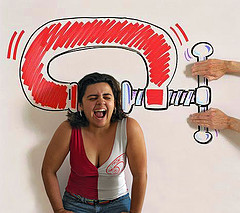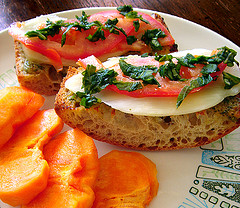Saved by sand - A new blood clotting material is saving lives
POLICE detective Danny ohnson was on patrol outside Tampa, Florida, when a report came through of a possible shooting in a junkyard three blocks away. Arriving on the scene, he found an elderly man sitting on a tractor, with a large hole in his leg that was bleeding profusely.
Realising it would be some time before the ambulance arrived, Johnson opened a packet of sand-like material and poured it into the wound. Within seconds, the bleeding had practically stopped, and the man survived. "The medic told me that had I
not put the substance in there, the guy would probably have bled out and died," he says.
The material, called QuikClot, which is issued routinely to police officers in Hillsborough County, Florida, was developed
for the US military to cut down the number of soldiers who bleed to death on the battlefield. More than 85% of soldiers killed in action die within an hour of being wounded. Improved haemorrhage control "could probably save 20% of the soldiers who are killed in action," says Hasan Alam, a trauma surgeon at Massachusetts General Hospital, Boston.
The material is already used by the US Navy and a few American police departments. Researchers would like to see it used more widely, but one major safety problem has prevented this happening. Now developers are hoping that advances in the material and the design of new substances could see blood clotting treatments used by ambulance crews, in operating theatres, and even in the home.
Every US Marine and Navy serviceman in Iraq and Afghanistan carries the material. Its maker, Z-Medica of WaUingford,
Connecticut, claims it has saved 150 lives so far. The porous mineral powder is poured into the wound, where pores quickly
absorb water, which concentrates the blood's clotting factors and so speeds up clotting. In lab tests, blood treated with the
material clots in less than two minutes, compared with the 10 minutes or so for untreated blood. In studies on pigs with
severed arteries, the survival rate was 100%; with a standard gauze dressing, more than half the animals died.
The safety problem in the way of the material's wider use arises because of the large amount of heat the material releases when it absorbs water, sometimes enough to cause second-degree burns. In the face of a life-threatening injury, this may be a price worth paying. "The general feeling around the department is that if I get shot, I don't care if it bums," Johnson says. Despite this, the Navy and Marines advise soldiers to apply the material only after all other methods have failed, and it's not standard issue for US Army troops.
Instead, they carry HemCon, a special bandage of ground-up shrimp shells. The shells contain chitosan, a substance which binds strongly to tissue and seals wounds in much the same way as a tire patch seals a tire. This material has its own problems: because it comes in a bandage, it's difficult to apply to deep or oddly shaped wounds. The bandage is also too stiff to be used to treat gunshot wounds effectively, as it cannot be packed into a hole to create enough pressure to control the bleeding. As a result, many Army units buy QuikClot regardless of the policy at the top, says Z-Medica CEO Ray Huey.
Being a powder, QuikClot can be poured into any shape of wound, but if it is to be used more widely it cannot harm those it treats. Researchers Galen Stucky and Todd Ostomel at the University of California, Santa Barbara, who are collaborating with Z-Medica, have found a way to tune the material to control the amount of heat it releases. They've also learned that there is
much more to how the substance accelerates clotting than just water absorption, and are using this knowledge to develop a new
generation of materials that work even faster and should prove more acceptable for civilian use.
QuikClot releases heat when positively charged calcium ions in its pores react with water molecules. Other positive ions
release less heat when they react with water, so Stucky and Ostomel swap some of the calcium ions in the material for silver
ions by soaking the material in a silver-containing solution. They can control how much of the calcium they replace, allowing them to tune the material to release as much or as little heat as they choose. "Having some heat is good," Stucky says. "It facilitates the clotting process."
Although a variety of ions can be used, silver is particularly good because it has antibacterial properties, even at very low concentrations. The drawback is that silver is expensive and signifi cantly raises the cost.
Stucky's group is building on this work to develop new materials to control bleeding during surgery. For a material to be most effective it must have a large surface area like QuikCIot, and since calcium acts as a cofactor in many
clotting reactions some calcium ions must be present.
The team's new material, a bioactive glass made of silica and calcium, has larger pores than 0uikClot and a different consistency. Its large surface area, and efficiency in releasing calcium ions, makes it clot blood even faster. The large pores allow bigger molecules, such as enzymes found in the blood's clotting cascade, to be incorporated in the material and released into the wound, which could further improve clotting.
Unlike QuikClot, which is hard to make in anything but powder form, the bioglass can be squeezed out of a syringe, like a
paste, which would be easier to apply during surgery. Bioglass can also be left in the body after surgery, where it will eventually be absorbed - unlike the QuikCiot particles, which have to be removed from the wound after bleeding has stopped, a fiddly and time-consuming process.
Meanwhile, Z-Medica is hoping that its new, safer version of QuikClot will be taken up not only by surgeons and emergency
crews, but also by individuals. "Ultimately, we hope everybody will have a first-aid kit with a pack in their car," says Huey. -Premium Health News Service/TMSl











